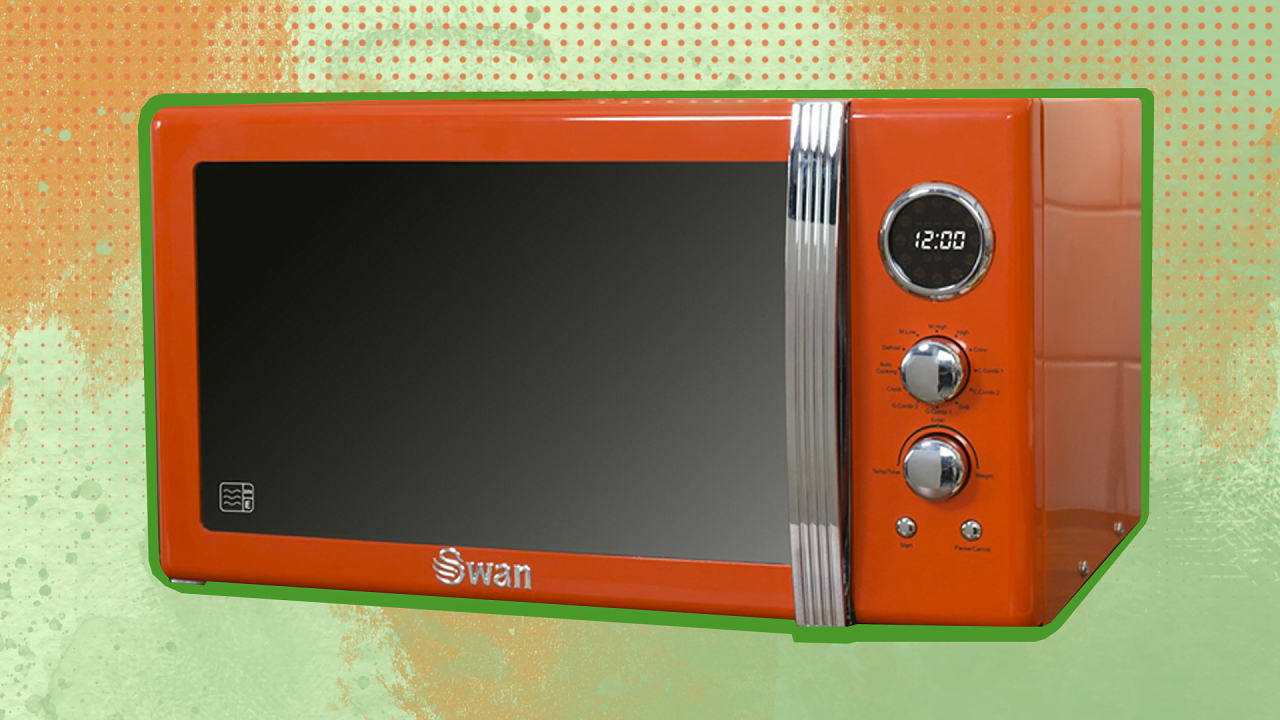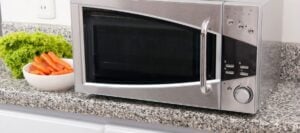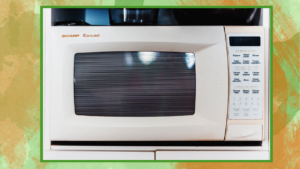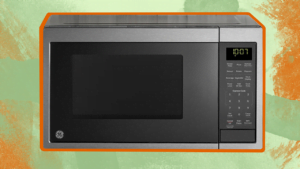What Size Microwave Do I Need? | Get the Perfect Fit!
Microwaves are a staple in most kitchens, sometimes taking over the role of a standard oven in food prep and cooking food. However, choosing the right size microwave can be difficult. The perfect fit for your kitchen and cooking needs will depend on several factors, including your family size, counter space dimensions, and desired wattage. […]

Standard Microwave Sizes by Type

Built-in Microwaves

Image Source A built-in microwave, also known sometimes as a convection oven, is popular among homeowners. You can open any drawer or cabinet and find a convection microwave inside. These microwaves are integrated into the kitchen cabinetry. You may find a built-in microwave as a drawer microwave or a wall oven, perfect for those with limited counter space. The typical microwave dimensions for built-in microwaves measuring 24 to 30 inches wide, 14 to 24 inches deep, and 16 to 22 inches tall. It takes up around 1.6 to 2.2 cu ft. of space. The internal dimensions, or the space inside the microwave, will vary depending on the model. But generally, a built-in microwave interior space ranges between 1.0 to 2.2 cu ft. Built-in microwaves generally meet standard cabinet dimensions. Make sure that the microwave fits standard cabinet widths. When considering where to install your built-in microwave, it’s important to remember the microwave door. You don’t want the open microwave door to swing out and hit something. Closed door depths range from 0.73 to 0.85 cubic feet for built-in microwaves. The open door depths range from 2.21 to 3.08 cubic feet. Built-in microwaves also tend to have higher wattage than countertop models, with most models ranging from 800 to 1200 watts.
- A sleek and sophisticated look that integrates seamlessly with kitchen cabinetry
- More advanced cooking features, such as convection cooking and grilling
- Wider temperature range for more advanced cooking techniques
- More expensive than other models, both in terms of the initial purchase price and installation costs
- More difficult to install, requiring professional installation during a kitchen remodel or renovation
- It can be more challenging to repair or replace if something goes wrong
Countertop Microwaves

Image Source Countertop microwaves are a popular and affordable option for those who want a simple and convenient way to heat food quickly. These compact microwaves are designed to sit on top of a counter or table and come in various sizes and styles to fit any kitchen. Countertop microwaves, or compact microwaves, come in various sizes, ranging from small to medium-sized microwaves. Standard microwave sizes generally range from 0.5 to 1.1 cubic feet, with widths ranging from 12 to 24 inches, and the microwave height typically ranges between 8 to 14 inches. The internal dimensions also vary depending on the compact microwave, but most models have a capacity of 0.5 to 1.0 cu ft, which can easily fit a plate or small casserole dish. When considering where to place it, it’s important to consider the door. Closed-door depths range from 0.5 to 0.7 cubic feet, and open-door depths range from 1.7 to 2.2 cubic feet. Another important factor to consider when choosing a mini microwave is wattage. Most compact models range from 600 to 1200 watts, offering faster and more cooking power.
- They are more affordable and easier to install since they don’t require professional installation
- Offer greater portability and can be easily moved from one location to another
- Take up less space and don’t require any permanent modifications to your kitchen
- Take up valuable counter space and may not fit well in smaller kitchens
- They may not have as many advanced cooking features or as high wattage, which can limit their versatility
Over-The-Range Microwaves

Image Source Over-the-range microwaves are a popular choice for those who want to save space in their kitchen. Over-the-range microwaves combine the functions of a microwave with those of a range hood, making them a convenient and practical addition to any kitchen. Over-the-range microwaves measured from 24 to 30 inches in width, in depth from 10 to 18 inches, and over-the-range height is 16 to 18 inches. The size ranges from 1.5 to 2.5 cubic feet. The internal capacity of an over-the-range microwave ranges from 1.5 to 2.2 cubic feet, similar to most countertop microwaves. It’s important to consider the depth of an over-the-range microwave when the door is closed and open. The closed-door depths typically range from 0.6 to 0.7 cubic feet, while the open-door depths can be as much as 2.6 to 3.5 cubic feet. This means you’ll need sufficient space above your range to accommodate the over-the-range microwave when the door is fully extended. Over-the-range microwaves generally have a higher wattage than countertop microwaves, ranging from 800 to 1200 watts. The temperature range in an over-the-range microwave is similar to other microwave types, typically heating food to a temperature of around 160°F to 200°F.
- Combines the functions of a microwave and range hood in one unit
- Fit any kitchen with different microwave sizes
- It can help remove smoke, steam, and cooking odors from the kitchen
- It requires professional installation
- It may not be suitable for all kitchen configurations, unlike most microwaves

How to Get Your Microwave Dimensions
If you’re looking to buy a new microwave, it’s important to know the dimensions of your current microwave or the size of your existing microwave enclosure.Exterior Dimensions
When measuring your new or current microwave, you’ll want to start with the external dimensions. This will give you an idea of how much cu. ft., it will occupy your countertop or cabinets. You’ll need a tape measure and a flat surface to place your microwave on to get started.- Measure width: Measure the width of your microwave from left to right. Make sure it fits the standard cabinet width.
- Measure height: Measure the microwave height from top to bottom. If the cabinet is too large, you can install a trim kit to fit your microwave.
- Measure depth: Measure the microwave depth from front to back. This is the distance from the front of the microwave to the back.
Interior Space
Once you have the external dimensions, you can measure the internal dimensions of your new microwave. This will give you an idea of how much space you have inside the microwave to cook or reheat food. You’ll need a tape measure and a flat surface to place your microwave on to get started.- Measure width: Measure the width of the inside of your microwave from left to right. This is the distance across the widest part of the microwave.
- Measure height: Measure the height of the inside of your microwave from top to bottom. This is the distance from the bottom of the microwave to the top.
- Measure depth: Measure the depth of the inside of your microwave from front to back. This is the distance from the front of the microwave to the back.
What Size Microwave Do I Need: Other Things to Consider
Aside from the microwave dimensions, there are a few other important factors to consider before purchasing. Let’s take a look at three key considerations:Microwave Wattage
The wattage is basically how powerful it is. A higher wattage means quicker cooking times. You might not need a high-wattage model using your countertop microwave to reheat leftovers or defrost frozen food. But if you want to whip up meals quickly and efficiently, a microwave with a higher wattage could be the way to go.Family Size
Think about the size of your family when choosing. A countertop model might be all you need if it’s just you or you’re living with a partner. If you’re feeding a big family or regularly cooking for guests, a larger microwave that can fit big dishes or cook multiple items at once could be a better choice.Ventilation Space
Ventilation space is also very important. It dictates how much food can fit inside. A countertop microwave might do the trick if you only use it occasionally. But if you frequently cook food in your microwave or use your appliance as your go-to kitchen tool, large microwaves might be the better option.Microwave Size FAQs
Now, let’s move on to some frequently asked questions about microwave sizes and features.
The size is an important consideration because it determines the amount and size of food that can be cooked or reheated at one time.
For more information, check out our article on the best small microwave.
Whether a 25L capacity is sufficient depends on the individual’s requirements and the size of the dishes they want to prepare or reheat.
A 25L capacity is typically large enough for most families, but large microwaves may be more suitable for cooking large quantities of food.
The ideal size of a countertop microwave oven for a family depends on their size and cooking needs.
A capacity of 1.0 to 1.6 cu ft. is usually sufficient for a family of four, but larger families may need a bigger appliance or more than one.
A convertible vent model can be used as a vented or recirculating microwave, while a recirculating model filters the air and returns it to the kitchen.
Look at our article on Convertible Vent Vs Recirculating Microwave for additional details.
A mixture of water and vinegar can be used to clean a microwave. The interior can be wiped with a soft cloth or sponge.
Check out our piece on How to Clean a Microwave for more details.

